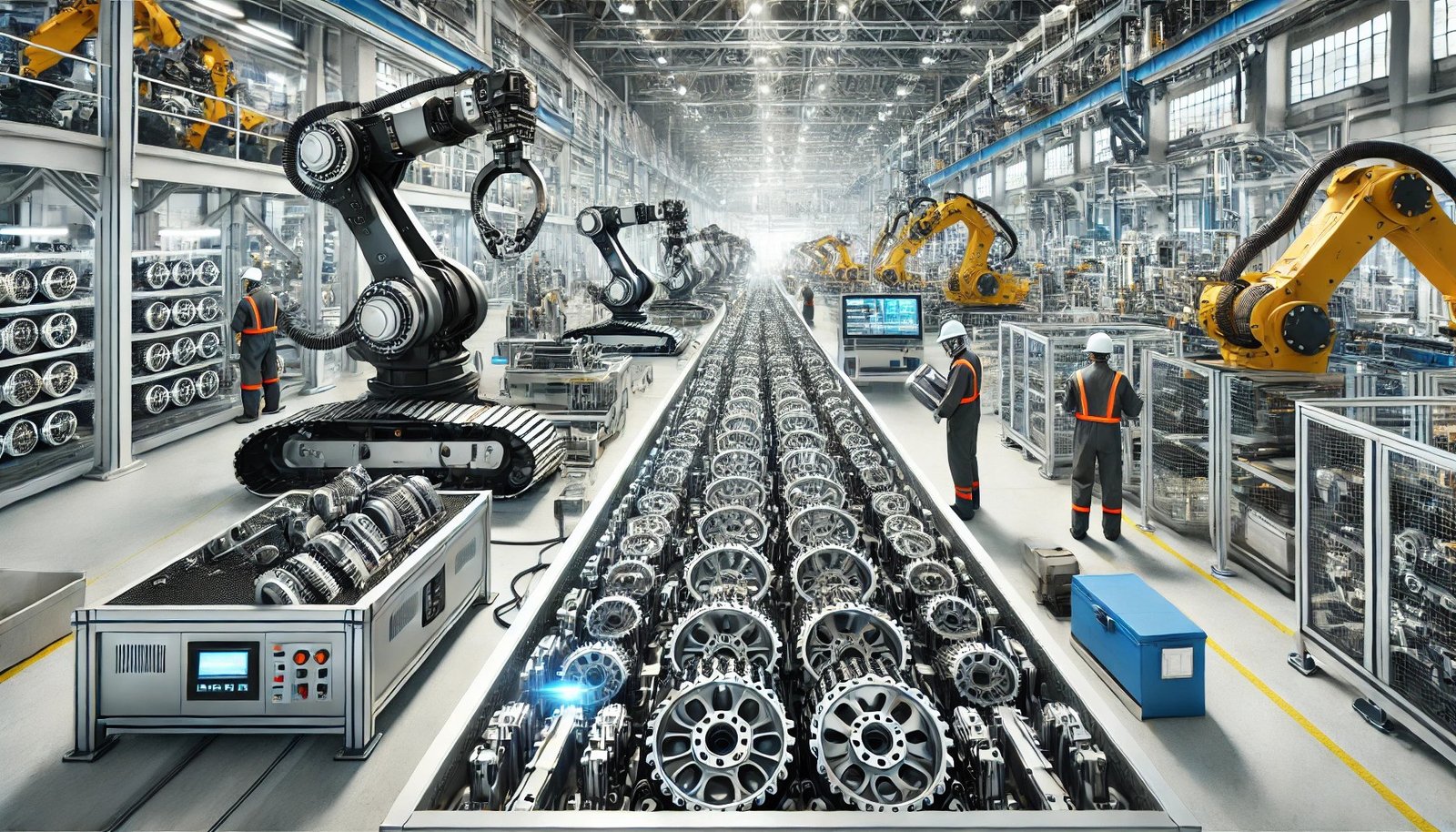Introduction to the Undercarriage Component Market
The global undercarriage component market has emerged as a crucial segment within the construction and mining industries, playing a significant role in enhancing the operational efficiency of heavy machinery. Undercarriage components mainly include tracks, rollers, sprockets, and idlers, which form the backbone of equipment such as excavators and bulldozers. These components are vital as they provide stability, mobility, and durability to machinery used in various demanding environments.
Currently, the undercarriage component market is valued at several billion dollars, reflecting its pivotal position in ensuring that construction and mining operations run smoothly. A multitude of factors contributes to the market’s current valuation, including increased construction activities, infrastructure development, and a growing demand for advanced machinery. The ongoing urbanization and industrialization trends across regions have further amplified the necessity for efficient undercarriage solutions, signaling a robust growth trajectory for this segment moving forward.
Projections for the undercarriage component market indicate a significant upward trend over the forecast period from 2024 to 2032. Industry analysts expect the market to witness a compounded annual growth rate (CAGR) that highlights the increasing investment in construction and mining sectors globally. Technological advancements, such as the development of superior materials and innovative design improvements in undercarriage systems, are also expected to drive further growth. Additionally, the rising focus on the maintenance and longevity of heavy machinery will likely foster a greater need for durable and high-performance undercarriage parts.
In light of these trends, a deeper analysis of market dynamics, including key players, regional developments, and collective impacts of economic factors, is essential to understand the future landscape of the global undercarriage component market.

Market Valuation and Growth Projections
The global undercarriage component market is currently valued at approximately $7.2 billion as of 2023. This valuation indicates a robust landscape for the industry, illustrating the significant demand for undercarriage components employed in various machinery, particularly in construction and mining sectors. The market is anticipated to witness substantial growth, with projections estimating a rise to $10.8 billion by the year 2032. This forecast highlights the expected expansion of the market over the next decade.
The projected Compound Annual Growth Rate (CAGR) of 4.5% between 2024 and 2032 reflects the favorable market conditions conducive to growth. This rate signifies a stable and consistent advancement, shaped by various factors such as technological innovations, increased infrastructure development, and rising demand for construction and mining operations globally. As machinery becomes more sophisticated, the requirement for dependable undercarriage components is expected to escalate, leading to enhanced sales and subsequent market valuation.
Understanding these growth projections is critical for stakeholders, including manufacturers, investors, and suppliers. Stakeholders who are informed about the market’s trajectory can make better strategic decisions, aligning their business operations to meet the evolving needs of the industry. The growth in market valuation not only indicates a climbing demand for undercarriage components but also illustrates potential investment opportunities within the sector.
Moreover, companies that recognize the significance of this growing market can engage in proactive measures such as research and development, which can further facilitate innovation and improve product offerings. In a competitive market environment, leveraging growth forecasts is essential for sustaining a competitive advantage and ensuring long-term profitability.

Driving Factors Behind Market Expansion
The global undercarriage component market is witnessing substantial growth, driven by several pivotal factors. Foremost among these are the construction and mining sectors, which play a critical role in the demand for undercarriage components. As urbanization accelerates worldwide, there is a notable surge in construction projects which necessitate the use of heavy machinery. This growing requirement for equipment, equipped with robust undercarriage systems, is a significant catalyst for market expansion.
Additionally, the mining industry is experiencing increased activity, particularly in regions rich in resources. Heavy machinery employed in mining operations relies heavily on durable undercarriage components to function efficiently in challenging terrains. As mineral extraction intensifies, the demand for high-performance undercarriages is poised to rise. Consequently, the growth of these two industries directly influences the market for undercarriage components.
Technological advancements are another element fueling the growth of this market. The introduction of innovative materials and engineering techniques has enhanced the performance and longevity of undercarriage components, making them more appealing to end-users. Companies are increasingly investing in research and development to create advanced undercarriage systems that offer improved efficiency and reduced maintenance costs. This not only contributes to market growth but also enhances customer satisfaction.
Furthermore, the increase in infrastructure spending across various nations is augmenting the market’s expansion. Governments are allocating larger budgets for infrastructure upgrades, ranging from roads to railways, further driving the need for heavy machinery outfitted with dependable undercarriage systems. This has created a favorable sector for manufacturers and suppliers within the global undercarriage component market.
In summary, the synergistic growth of the construction and mining sectors, coupled with technological advancements and increased infrastructure investment, collectively drives the expansion of the global undercarriage component market. Understanding these dynamics will be crucial for stakeholders aiming to capitalize on burgeoning opportunities in this sector over the coming years.
Market Segmentation: Components Overview
The global undercarriage component market can be segmented into several key components, each playing a vital role in the performance and longevity of heavy machinery. The primary components include track rollers, carrier rollers, track chains, idlers, and sprockets. Understanding the importance and functions of each component is essential for stakeholders in the industry.
Track rollers are critical elements that support the weight of the machinery during operation. They help in distributing the load evenly, which reduces wear and tear on the undercarriage system, thus enhancing durability. Efficient track rollers contribute to smoother operation and reduced stress, ultimately increasing machinery efficiency.
Carrier rollers serve as a stabilizing mechanism, primarily designed to support the track in a suspended position. Their role is pivotal in maintaining proper alignment and minimizing friction during movement. This reduction in friction not only prolongs the lifespan of the undercarriage components but also contributes to the efficient power transfer within the machinery, shooting up operational efficiency.
Track chains, vital to the overall undercarriage system, create a reliable connection between various components, facilitating movement and allowing for the transfer of power from the engine to the tracks. The strength and design of the track chains determine how effectively the machinery can work under various environmental conditions. High-quality track chains ensure exceptional performance, reducing the risks of breakdowns and costly downtimes.
Additional components, such as idlers and sprockets, also play significant roles. Idlers help guide the tracks and maintain tension, while sprockets engage with the track chains to facilitate movement. Collectively, these components form an integral part of the undercarriage system, influencing not just performance but also cost-efficiency and maintenance needs.
Market Segmentation: Equipment and Their Roles
The global undercarriage component market is fundamentally shaped by the types of equipment that utilize these essential parts, notably crawler excavators and mini excavators. These machines are critical in various construction, mining, and agricultural applications, demonstrating their versatility and importance within the industry. Crawler excavators, which are equipped with tracks rather than wheels, are designed for superior traction and stability, making them suitable for rough terrains and heavy-duty tasks. Their robust nature allows them to perform effectively in various environments, including soft, muddy grounds that pose challenges for wheeled vehicles.
Conversely, mini excavators, smaller in size, offer maneuverability and efficiency in more confined spaces. They are increasingly favored in urban development projects, landscaping, and residential work, where space limitations often come into play. The demand for mini excavators has been rising steadily, owing to their versatility and the growing trend towards small-scale construction projects that require efficient, precisely operated machinery.
Current market trends indicate a robust increase in the adoption of these excavators due to infrastructure development and urbanization. As countries globally focus on enhancing their infrastructure, the utilization of crawler and mini excavators is expected to surge. Furthermore, technological advancements in undercarriage components, such as improved materials for durability and efficiency, are likely to impact market growth positively. End-users are now more inclined towards machines that offer not only effectiveness but also longevity and low maintenance costs. Ultimately, the segmentation of the undercarriage component market based on equipment reveals significant insights into how these machines operate and the vital roles they play in the industry’s advancement.
End User Industries Analysis
The global undercarriage component market is significantly influenced by key end-user industries, primarily construction and mining. These sectors are characterized by unique demands and requirements that shape the overall consumption patterns of undercarriage parts. As heavy machinery is a fundamental aspect of both industries, understanding the specific needs of these sectors is essential for manufacturers and suppliers of undercarriage components.
In the construction industry, undercarriage components are critical to the operation of earthmoving machinery such as excavators, bulldozers, and crawler cranes. The construction industry’s focus on durability and efficiency means that there is a high demand for undercarriage parts that can withstand robust working conditions. Components must not only be strong but also designed to facilitate ease of maintenance and replacement. This demand for reliability influences the market, encouraging innovation and technological advancements in component design and manufacturing processes. Moreover, as urbanization accelerates globally, the construction industry’s growth is anticipated to further fuel the demand for undercarriage components.
Similarly, the mining industry plays a pivotal role in shaping the undercarriage component market. Mining operations often involve navigating challenging terrains and operating heavy machinery under extreme conditions. As a result, the undercarriage components used within this sector must demonstrate superior strength, wear resistance, and adaptability to diverse working environments. The increasing scale of mining projects, coupled with the gradual shift towards automation and advanced machinery, is likely to create additional demand for specialized undercarriage solutions. As these industries continue to evolve, their specific requirements will drive market trends, emphasizing the need for component manufacturers to stay attuned to the changing dynamics of their end-user industries.
Regional Market Analysis: The Dominance of Asia-Pacific
The Asia-Pacific region has emerged as a significant player in the global undercarriage component market, driven by rapid industrialization and substantial infrastructure development. Countries like China, India, and Japan are at the forefront of this growth, contributing to the increasing demand for undercarriage components used in heavy machinery and construction equipment. China, in particular, has experienced an unprecedented surge in infrastructure projects, bolstered by initiatives such as the Belt and Road Initiative (BRI). This ambitious plan aims to enhance global trade and stimulate economic growth across multiple countries in the region, thereby creating a robust market for undercarriage components.
As one of the core areas of the BRI, China’s investments in transportation and logistics infrastructure have resulted in a heightened demand for construction machinery and, consequently, undercarriage components. This trend is not limited to China alone; neighboring countries are also experiencing similar investments in infrastructure. For instance, India’s Government’s commitment to development through its “Make in India” initiative has led to a greater focus on local manufacturing capabilities, fostering a conducive environment for the undercarriage component market in the region.
Moreover, the Asia-Pacific undercarriage component market is characterized by a growing number of regional players and investments from global firms. These companies are focused on technological advancements aimed at improving the durability and efficiency of undercarriage components. Furthermore, a noteworthy trend is the increasing adoption of electric-powered machinery, which is expected to influence the types of undercarriage components developed and released into the market. The region’s market dynamics, influenced by urbanization and increased construction activities, are set to grow steadily through the forecast period. The underlying trends in the Asia-Pacific market suggest an ongoing evolution driven by infrastructure demands and innovative practices in manufacturing.
Emerging Markets: Opportunities in Latin America and the Middle East
The global undercarriage component market is witnessing a considerable shift towards emerging markets, particularly in Latin America and the Middle East. These regions present unique opportunities for growth, driven by several factors including increasing infrastructure investment, urbanization, and rising demand for construction equipment. With economic development progressing in various Latin American countries, there is a heightened emphasis on building robust infrastructures such as roads, bridges, and public utilities. This infrastructure boost directly contributes to the demand for high-quality undercarriage components that are essential for heavy machinery operation.
In Latin America, countries like Brazil and Mexico are prioritizing their transportation networks, thereby stimulating the need for machinery equipped with advanced undercarriage systems. The region also benefits from expansive mining activities, which further amplify the necessity for reliable undercarriage solutions. Similarly, the Middle East is experiencing a construction boom, initiated by large-scale projects in places like Saudi Arabia and the UAE. The Vision 2030 initiative in Saudi Arabia, focusing on diversifying the economy, includes extensive industrial projects requiring sophisticated machinery, thus creating substantial demand for durable undercarriage components.
However, while the potential for growth in these regions is substantial, several challenges must be navigated. Political instability, regulatory hurdles, and fluctuating currency values can affect investment levels and market dynamics. Nevertheless, companies that can adeptly adapt to local market conditions and foster relationships with key stakeholders may find themselves well-positioned to capitalize on these emerging opportunities.
In conclusion, the undercarriage component market is set to expand significantly in emerging regions like Latin America and the Middle East. By addressing the inherent challenges and leveraging the advantages of these markets, industry players can play a vital role in driving overall market growth in the coming years.
Conclusion and Future Outlook
In reviewing the analysis of the global undercarriage component market, several key takeaways emerge that highlight its significant growth potential. The period from 2024 to 2032 is anticipated to witness robust expansion, driven by increasing demand across various sectors including construction, mining, and agriculture. The evolution of technology and advancements in materials utilized for undercarriage components are projected to further enhance product durability and performance, thereby attracting more investments into the market.
Understanding the driving factors behind this growth is crucial for stakeholders. Key elements influencing the market include the rise in construction activities, the need for efficient machinery, and the growing awareness of maintenance practices that prolong machinery life. Additionally, environmental regulations and sustainability concerns have prompted manufacturers to innovate and develop eco-friendly undercarriage solutions, which will likely play a pivotal role in shaping future offerings.
Regional dynamics also significantly impact the global undercarriage component market. Emerging economies are expected to contribute substantially to the market growth due to infrastructural developments and increased urbanization. Furthermore, the competitive landscape is evolving, with both established players and new entrants vying for market share through strategic partnerships and technological advancements. This competitive drive will not only enhance product offerings but also ensure that prices remain competitive, benefiting end-users.
In conclusion, the global undercarriage component market is poised for considerable growth by 2032, fueled by a combination of technological advancements and changing market demands. Stakeholders must remain vigilant in understanding regional dynamics and key driving factors to effectively navigate this evolving landscape and seize emerging opportunities within the market.
Citations:
[1] https://www.alliedmarketresearch.com/undercarriage-component-market-A53635
[2] https://www.factmr.com/report/1623/undercarriage-components-market
[3] https://www.fortunebusinessinsights.com/undercarriage-systems-market-104589
Latest Posts:
- $6.6 Billion by 2033: Is the Aircraft Lighting Industry Flying Blind?
- $27.4 Billion by 2030: Are We Overlooking the Risks in the Operating Room Equipment Market?
- From $7.2 Billion to $10.8 Billion: What’s Driving the Growth of Undercarriage Components Market?
- U.S. Dental Market to Hit $260 Billion by 2033: What’s Driving the Growth?
- Bouncing Back Stronger: Strategies to Inspire Your Team After a Project Setback

